Wright Aeronautical
Wright R-3350 Turbo Compound Power Recovery Turbine Fluid Couplings
by Tom Fey
Articles by Carl Kuhns
Curtiss Wright Turbo Compound Data Plate Sampling
Wright Cyclone Licensees
Wright Aero Helicopter Engines
The Cyclone 7
Turbocompounds
Turbocompound Blower Drive Failures
Articles by Jay Smith
R-2600 Lockland Investigation
R-2600 Case History
Curtiss-Wright Cyclone 22 (Military XR-4090)
Curtiss, Lawrance and Wright Engine Specifications
The Curtiss-Wright SGV-1800
Wright L-320 Gipsy Parts Catalog Donated by John Riend
Wright J-3 50-hour Test
Wright J-4A Endurance Tests
Wright J-5A 100-hour Full-Throttle Endurance Test
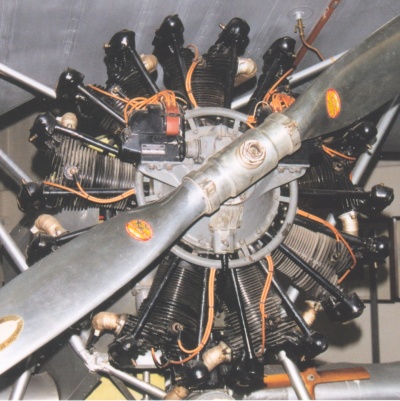 |
Wright J-5 "Whirlwind"
By Kimble D. McCutcheon
On May 21, 1927, Charles A. Lindbergh stunned the world by flying solo and non-stop from New York to Paris in an airplane powered by a single Wright J-5 Whirlwind engine. To accomplish this, the engine had to run continuously for over 33 hours. The astounding thing is that only five years before, no successful air-cooled engine even existed in the United States. The story of this engine is not about one man’s revolutionary genius, but rather of the evolutionary effort of many individuals and organizations who collectively produced an engine that was light, reliable, maintainable, and had good fuel consumption. This was done in the classical engineering development tradition — the cycle of designing, testing, and improving. With the exception of supercharging, propeller reduction gearing, turbocompounding, and direct fuel injection, the J-5 was everything an air-cooled engine would ever be.
- more -
|
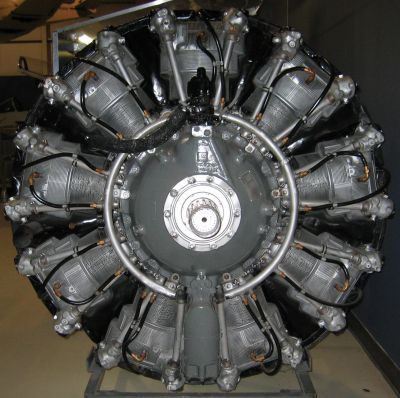 |
Wright R-1820 "Cyclone"
By Kimble D. McCutcheon
If you were a child in the years of 1964 through 1969, your introduction to the sights and sounds of the Wright R-1820 "Cyclone" was probably due to the popular television series "Twelve O’clock High". In this series, Boeing B-17 bombers flew missions over Germany each week and the heroes always returned home due to guts, skill, and sturdy aircraft with reliable engines. More importantly, a whole generation of kids was introduced to radial engines with their smoky starts and monotonous low drone long before restored B-17s started touring the air-show circuit and before "Warbird" entered the lexicon of aviation enthusiasts everywhere.
- more - |
 |
Wright R-3350 "Cyclone 18"
By Kimble D. McCutcheon
On September 29, 1946, a Navy P2V1 Neptune named the Truculent Turtle; left Perth, Australia and flew 11,236 miles unrefueled to Columbus, Ohio, a record that stood until the Voyager flight around the world during the fall of 1986. The P2V1 was powered by two Wright R-3350 Cyclones. It is hard to believe that a record-setting engine such as this had one of the most difficult developments of any aircraft engine ever to see production. This was largely due to an extremely compressed schedule that tried to do in two years what ordinarily took five. The development also took place in public whereas normally the growing pains of a new engine happen behind the closed doors of test cells, engine development labs, and in private flight tests.
- more - |
"Hex" Engine Firing Orders
by Kimble D. McCutcheon
Both Curtiss and Curtiss-Wright built unique 12-cylinder "Hex" engines arranged as double-row radials with six cylinders per row. The air-cooled Curtiss H-1640 "Chieftain" was intended to be a commercial engine, but was also tested by the U.S. Navy. The liquid-cooled H-2120 was built exclusively for the U.S. Navy. We have all been taught that a four-stroke radial engine must have an odd number of cylinders per row in order to achieve even firing, yet these two Hex engines were even firing. How was this accomplished?
For engines such as these with 180° crankshafts and overhead camshafts for each cylinder bank, three possible schemes will provide even firing:
- Fire all the cylinders in one row successively, then all the ones in the other row;
- Fire a cylinder in one row and then fire the opposite-row cylinder situated 240° in the direction of crankshaft rotation. Twice in each cycle, fire two adjacent cylinders in the same row. This was the scheme used by the H-1640
- Fire two adjacent cylinders in the same row, followed by an opposite-row cylinder 240° in the direction of crankshaft rotation. This scheme was used by the H-2120.
The H-1640 was tested twice by the U.S. Navy in the late 1920s. According to Navy reports, each had a different firing order and different master rod placement. Both test reports complained of excessive vibration. Neither test was successful. A new liquid-cooled hex engine, the Curtiss-Wright H-2120, was tested by the Navy in the 1930s. Again, the master rod location and firing order was changed. Again, the engine was not accepted for Navy use.
The tinkering with firing order and master rod location suggests that the engine designers were trying to resolve some underlying vibration issue. Master rod placement allows some control over the amplitude, frequency and direction of vibration. It is also possible to obtain good torsional vibration characteristics at the expense of overall linear "shake", and vice versa. With the Curtiss Hex engines, three master rod phasing schemes were tired: 0°, ~90°, and 180° apart.
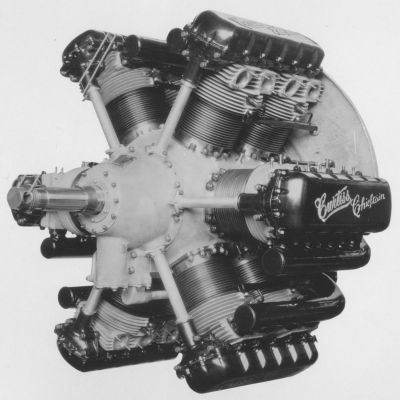 |
 |
| Curtiss H-1640 Chieftain |
Curtiss-Wright H-2120 |
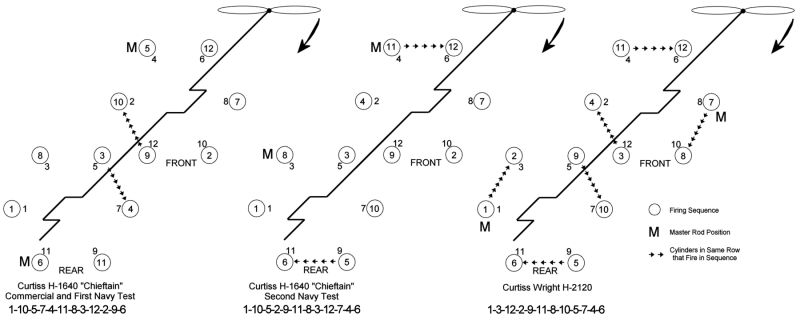 |
Wright R-2160 Tornado Restoration
Raymond Zanella Kindly Contributed the Following Tornado Restoration Images
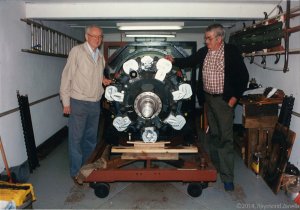 |
 |
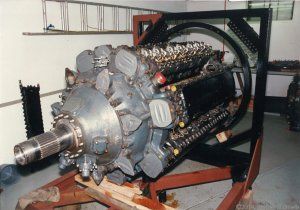 |
 |
| Tornado Restorers Jerry Abbamont (left) and Kenny Bell stand beside the Tornado during restoration. |
Front Section Being Prepared for Painting. The engine is upside down in this image. At the nose case top is a mounting pad for the front oil scavenge pump; at the left is the propeller governor mounting pad. The remaining pads are covers for other accessory drives. |
Two Mounting Pad Circles Aft of the Nose Case. The triangular front ones are for the seven magnetos; the larger ones aft are camshaft drive gear covers. |
One of the magneto drives (above right of the image center) has not yet been masked. The drive shaft and three threaded holes for mounting bolts are visible. |
 |
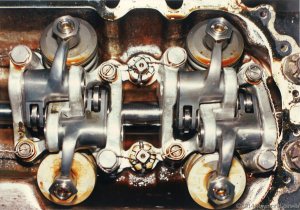 |
 |
 |
| In this view of the vee between cylinder banks, the masked-off exhaust flange is visible along one wall (top), and intake ports are visible on the other (bottom). The large aft hole leads to the supercharger. Spark plugs, ignition harness, cooling air blast tubes, an intake manifold and an exhaust manifold, along with their attaching hardware, had to be fitted into this very tight space. This same scheme was used for all seven cylinder banks. |
Camshaft, Rocker Arms, and Valves for Two Cylinders. Each of the 84 valves had to be adjusted manually, which required removal and replacement of 7 valve covers, each with 50 lock-wired fasteners and a gasket. |
The rear accessory case has been removed, exposing the supercharger impeller. |
Supercharger impeller and passages to the seven intake manifolds. |
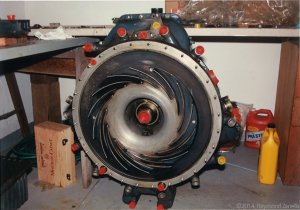 |
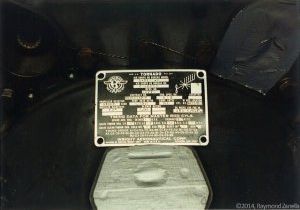 |
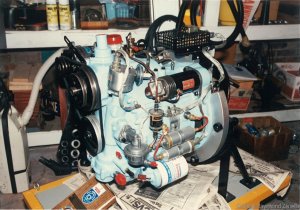 |
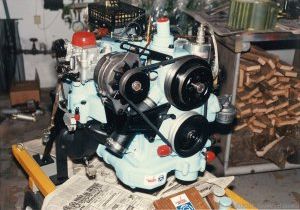 |
| Accessory Case Showing the Supercharger Diffuser |
Tornado Data Plate |
The Curtiss-Wright RC-260-Y8 rotary combustion engine that the New Jersey Aviation Hall of Fame and Museum traded to the New England Air Museum for the Tornado. |
Curtiss-Wright RC-260-Y8 |

















